Abstract
BACKGROUND AND OBJECTIVE--Lithium has occasionally been reported to cause symptomatic sinus node bradyarrhythmias. The prevalence and mechanism of these arrhythmias during long-term treatment are unknown. The aims of this study were (a) to evaluate the systemic effects of lithium treatment on cardiac conduction in individuals who were free from cardiovascular disorders; (b) to assess the prevalence of lithium treatment in a group of patients with pacemakers; and (c) to evaluate the interaction between the parasympathetic limb of the autonomous nervous system and the sinus node cells during long-term lithium treatment. PATIENTS AND METHODS--45 patients who had been treated with lithium for > 12 months were investigated in a long-term electrocardiography study. Only patients without cardiovascular disease, or concomitant chronotropic medication, or metabolic disorders known to cause rhythm disturbances were included. An age-stratified population was used as a reference group. 21 patients also underwent analysis of carotid sinus pressure and sinus cycle length before and after atropine to clarify whether neural mechanisms were involved. The prevalence of lithium treated patients was determined in 650 patients with pacemakers. RESULTS--(a) Signs of moderate sinus node dysfunction (sinus arrest > 1.5 s, minimum heart rate < 50 beats/min) were found in 56% and 78% respectively in the lithium-treated group compared with 30% and 30% respectively in the reference group (p < 0.01). Severe sinus node dysfunction was equally common in both groups. (b) The prevalence of chronic lithium treatment in the pacemaker population was 0.46%. (c) Sinus cycle variations were abnormal in the basal state in three (14%) patients and in 11 (52%) patients after atropine despite signs of intact and normal parasympathetic innervation. CONCLUSIONS--Depressed sinus node function was significantly more common in a lithium-treated population than in an age-stratified reference group. Clinically significant dysfunction, however, was uncommon. The effect of lithium on the sinus node seemed to be intrinsic and was not caused by increased parasympathetic tone.
Full text
PDF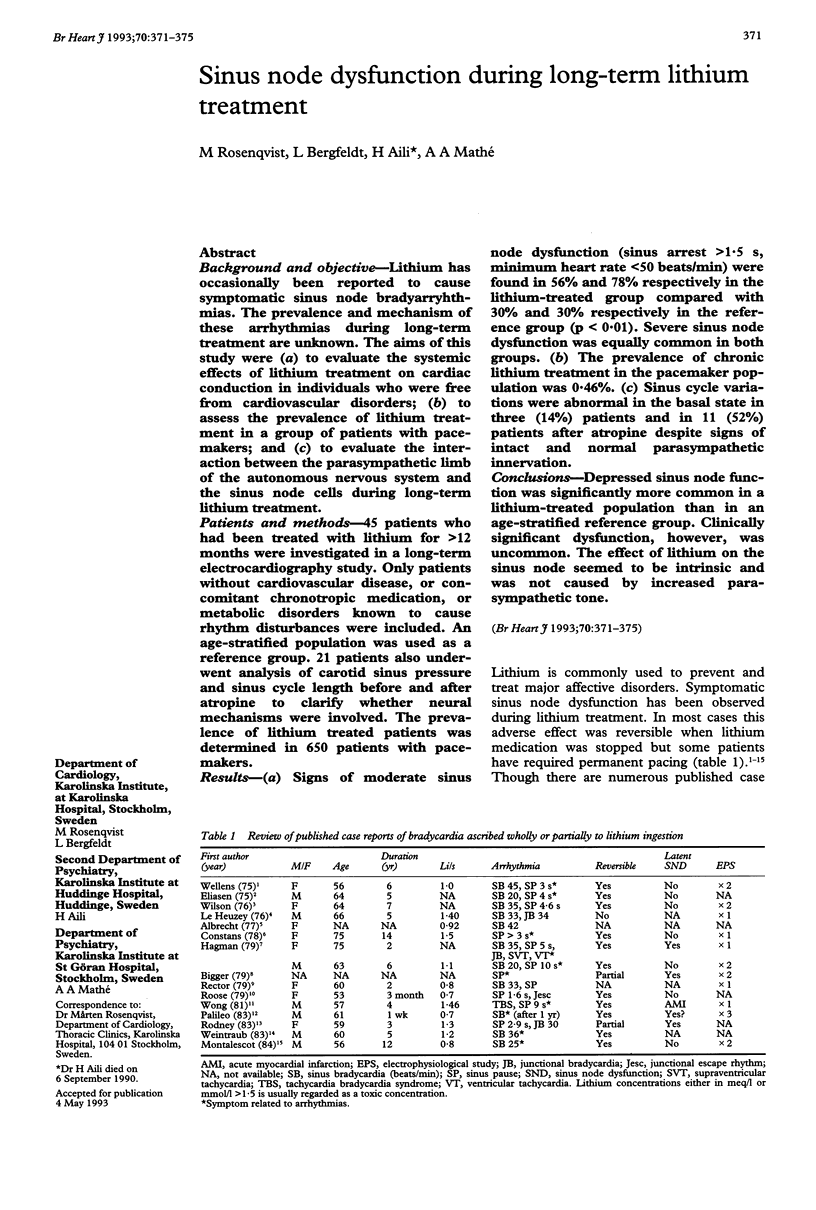
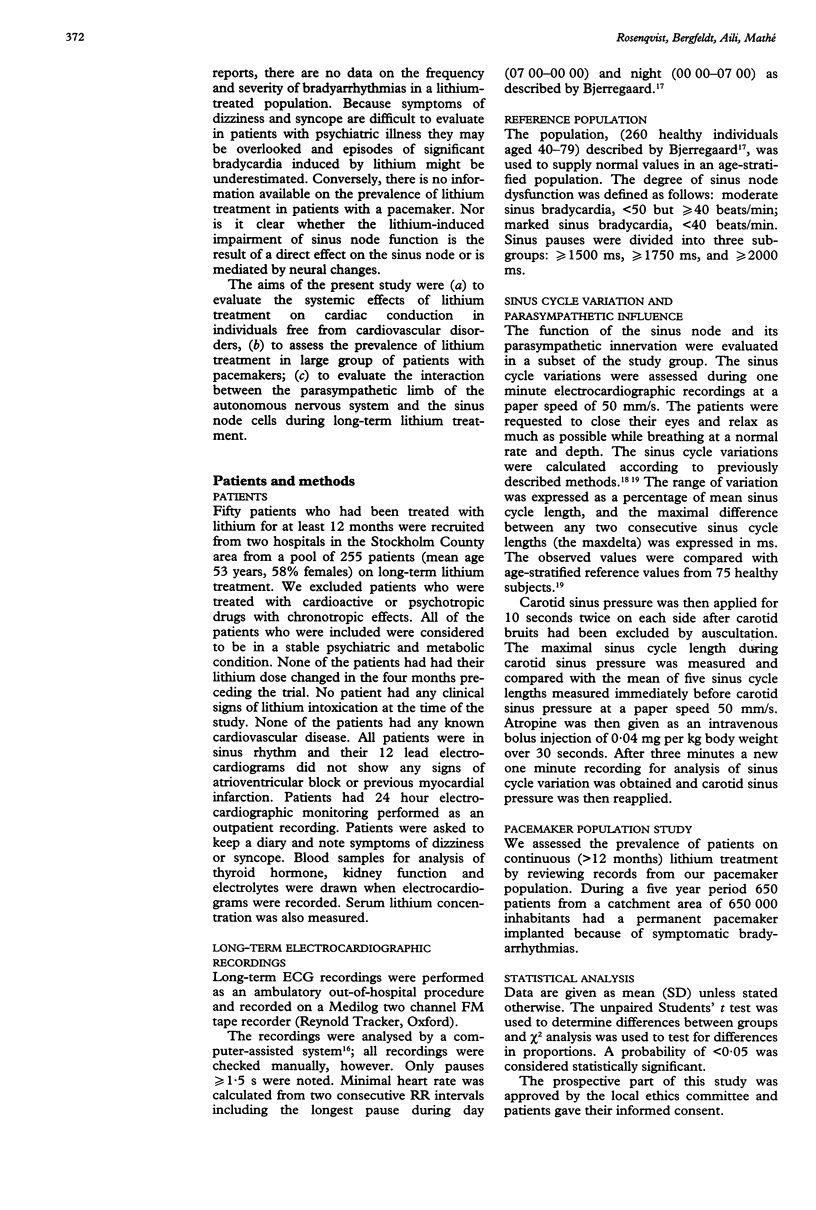
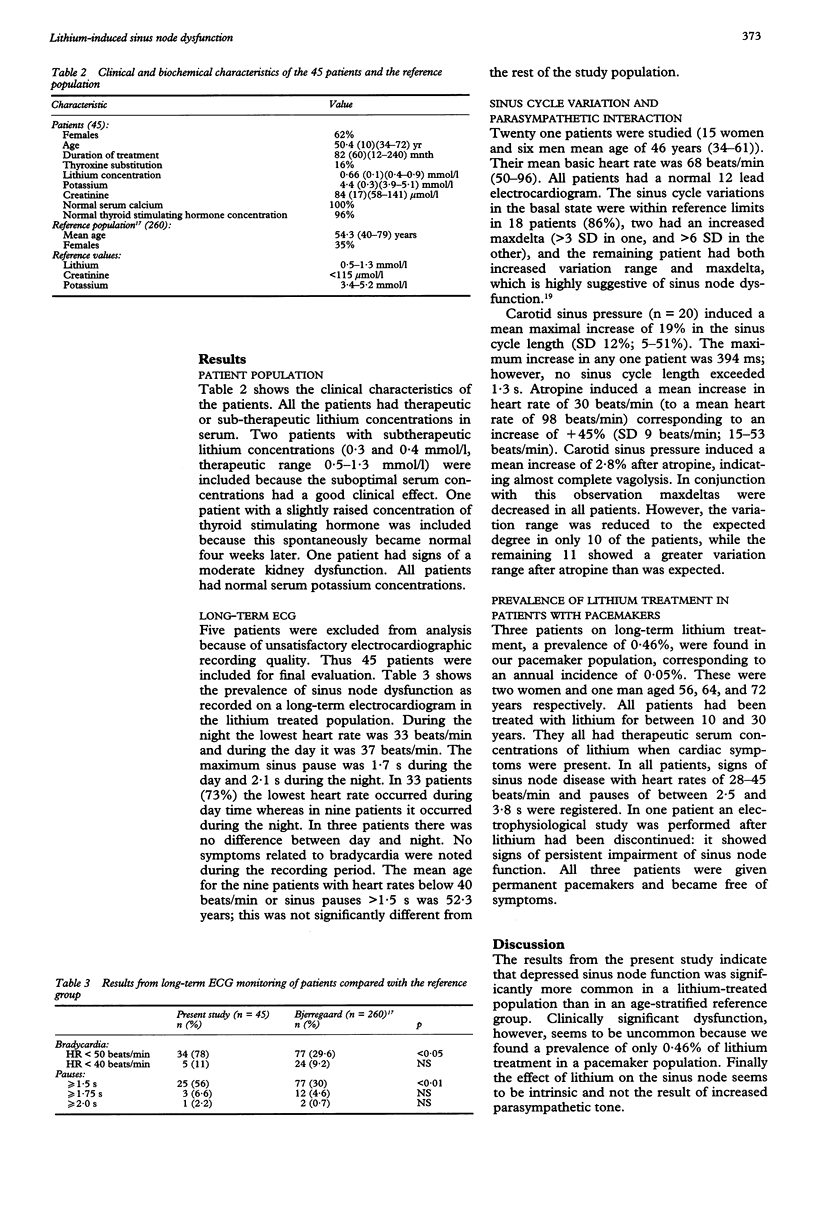
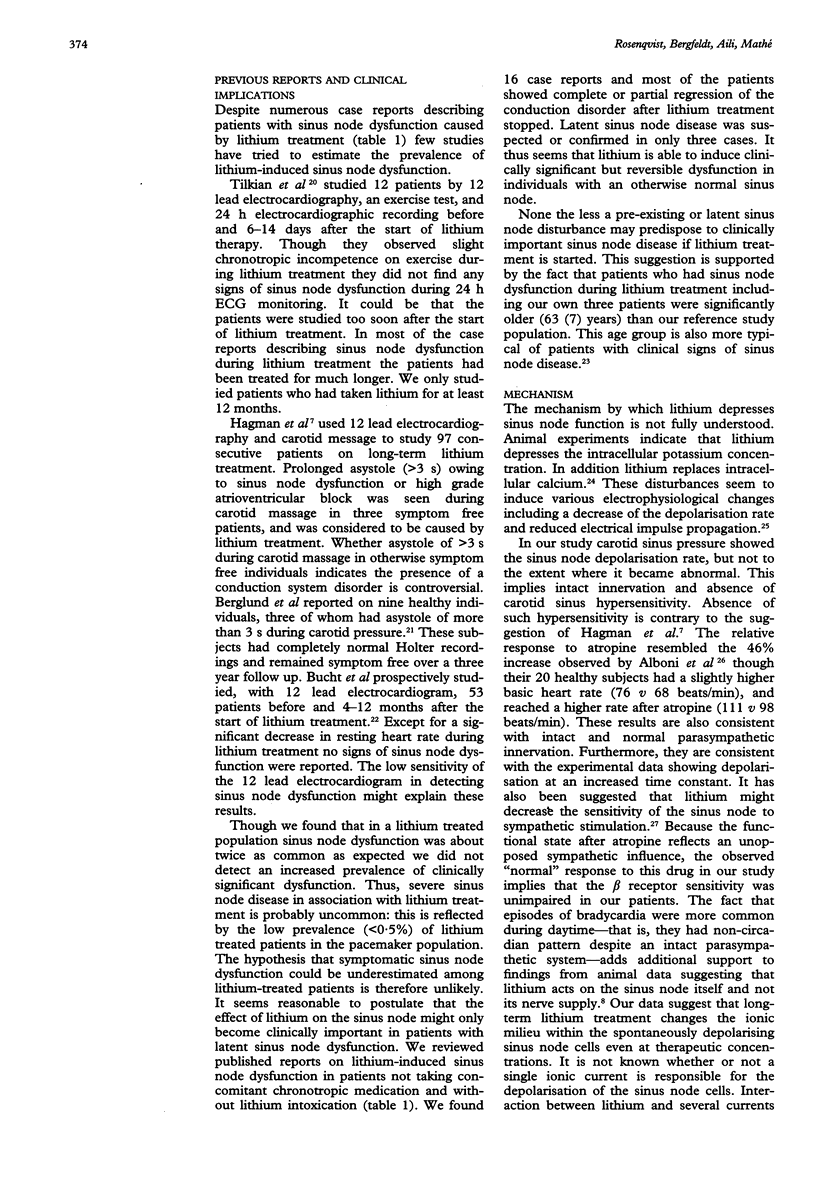
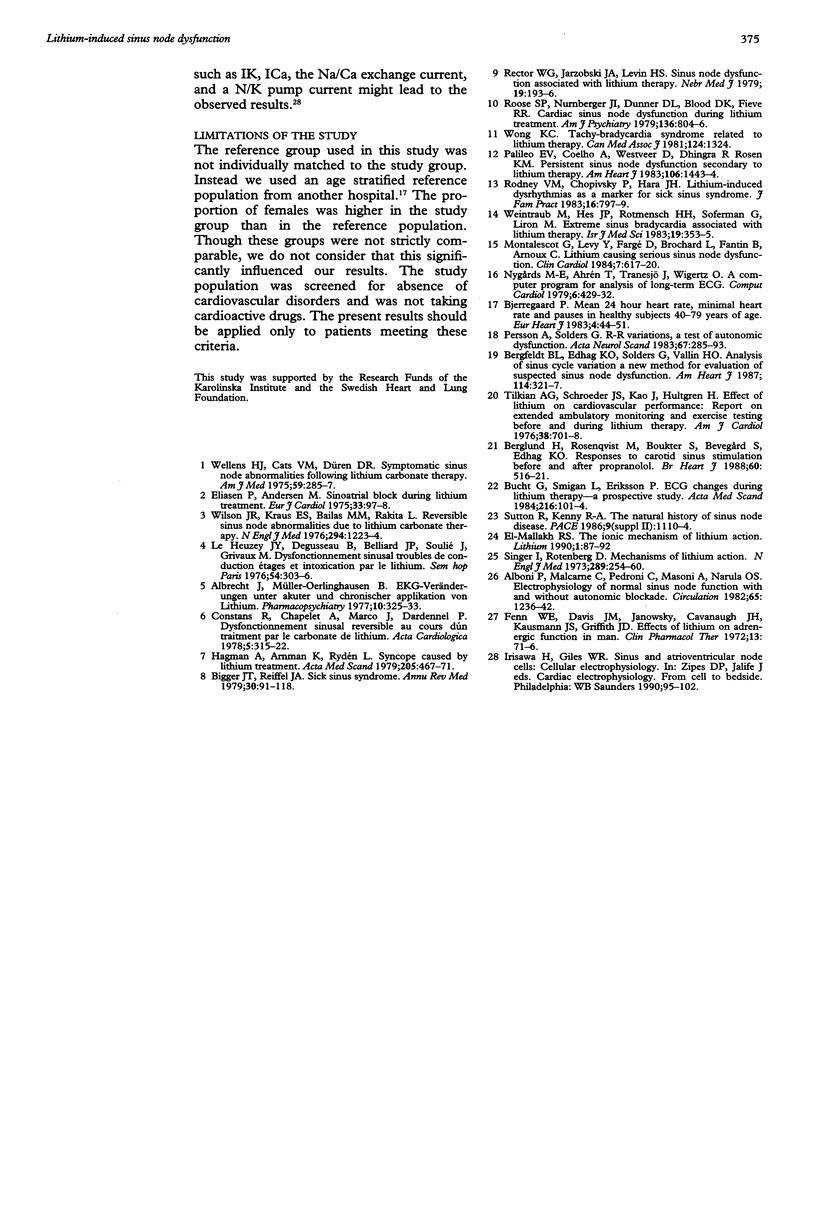
Selected References
These references are in PubMed. This may not be the complete list of references from this article.
- Alboni P., Malcarne C., Pedroni P., Masoni A., Narula O. S. Electrophysiology of normal sinus node with and without autonomic blockade. Circulation. 1982 Jun;65(6):1236–1242. doi: 10.1161/01.cir.65.6.1236. [DOI] [PubMed] [Google Scholar]
- Albrecht J., Müller-Oerlinghausen B. EKG-Veränderungen unter akuter und chronischer Applikation von Lithium. Pharmakopsychiatr Neuropsychopharmakol. 1977 Dec;10(6):325–333. doi: 10.1055/s-0028-1094557. [DOI] [PubMed] [Google Scholar]
- Bergfeldt B. L., Edhag K. O., Solders G., Vallin H. O. Analysis of sinus cycle variation: a new method for evaluation of suspected sinus node dysfunction. Am Heart J. 1987 Aug;114(2):321–327. doi: 10.1016/0002-8703(87)90498-4. [DOI] [PubMed] [Google Scholar]
- Berglund H., Rosenqvist M., Boukter S., Bevegård S., Edhag K. O. Responses to carotid sinus stimulation before and after propranolol. Br Heart J. 1988 Dec;60(6):516–521. doi: 10.1136/hrt.60.6.516. [DOI] [PMC free article] [PubMed] [Google Scholar]
- Bigger J. T., Jr, Reiffel J. A. Sick sinus syndrome. Annu Rev Med. 1979;30:91–118. doi: 10.1146/annurev.me.30.020179.000515. [DOI] [PubMed] [Google Scholar]
- Bjerregaard P. Mean 24 hour heart rate, minimal heart rate and pauses in healthy subjects 40-79 years of age. Eur Heart J. 1983 Jan;4(1):44–51. doi: 10.1093/oxfordjournals.eurheartj.a061370. [DOI] [PubMed] [Google Scholar]
- Bucht G., Smigan L., Wahlin A., Eriksson P. ECG changes during lithium therapy. A prospective study. Acta Med Scand. 1984;216(1):101–104. doi: 10.1111/j.0954-6820.1984.tb03777.x. [DOI] [PubMed] [Google Scholar]
- Constans R., Chapelet A., Marco J., Dardenne P. Dysfonctionnement sinusal réversible au cours d'un traitement par le carbonate de lithium. Acta Cardiol. 1978;33(5):315–322. [PubMed] [Google Scholar]
- Cumulative eight-year index. Volumes 1-8, 1978-1985. Pacing Clin Electrophysiol. 1986 Jan;9(1 Pt 2):1–31. [PubMed] [Google Scholar]
- Eliasen P., Andersen M. Sinoatrial block during lithium treatment. Eur J Cardiol. 1975 Aug;3(2):97–98. [PubMed] [Google Scholar]
- Fann W. E., Davis J. M., Janowsky D. S., Cavanaugh J. H., Kaufmann J. S., Griffith J. D., Oates J. A. Effects of lithium on adrenergic function in man. Clin Pharmacol Ther. 1972 Jan-Feb;13(1):71–77. doi: 10.1002/cpt197213171. [DOI] [PubMed] [Google Scholar]
- Hagman A., Arnman K., Rydén L. Syncope caused by lithium treatment. Report on two cases and a prospective investigation of the prevalence of lithium-induced sinus node dysfunction. Acta Med Scand. 1979;205(6):467–471. [PubMed] [Google Scholar]
- Le Heuzey J. Y., Degusseau B., Belliard J. P., Soulié J., Grivaux M. Dysfonctionnement sinusal, troubles de conduction étagés et intoxication par le lithium. Sem Hop. 1978 Mar;54(5-8):303–306. [PubMed] [Google Scholar]
- Montalescot G., Levy Y., Farge D., Brochard L., Fantin B., Arnoux C., Hatt P. Y. Lithium causing a serious sinus-node dysfunction at therapeutic doses. Clin Cardiol. 1984 Nov;7(11):617–620. doi: 10.1002/clc.4960071113. [DOI] [PubMed] [Google Scholar]
- Palileo E. V., Coelho A., Westveer D., Dhingra R., Rosen K. M. Persistent sinus node dysfunction secondary to lithium therapy. Am Heart J. 1983 Dec;106(6):1443–1444. doi: 10.1016/0002-8703(83)90063-7. [DOI] [PubMed] [Google Scholar]
- Persson A., Solders G. R-R variations, a test of autonomic dysfunction. Acta Neurol Scand. 1983 May;67(5):285–293. doi: 10.1111/j.1600-0404.1983.tb04577.x. [DOI] [PubMed] [Google Scholar]
- Rector W. G., Jr, Jarzobski J. A., Levin H. S. Sinus node dysfunction associated with lithium therapy: report of a case and a review of the literature. Nebr Med J. 1979 Jul;64(7):193–193. [PubMed] [Google Scholar]
- Rodney W. M., Chopivsky P., Hara J. H. Lithium-induced dysrhythmias as a marker for sick sinus syndrome. J Fam Pract. 1983 Apr;16(4):797–799. [PubMed] [Google Scholar]
- Roose S. P., Nurnberger J. I., Dunner D. L., Blood D. K., Fieve R. R. Cardiac sinus node dysfunction during lithium treatment. Am J Psychiatry. 1979 Jun;136(6):804–806. doi: 10.1176/ajp.136.6.804. [DOI] [PubMed] [Google Scholar]
- Singer I., Rotenberg D. Mechanisms of lithium action. N Engl J Med. 1973 Aug 2;289(5):254–260. doi: 10.1056/NEJM197308022890508. [DOI] [PubMed] [Google Scholar]
- Tilkian A. G., Schroeder J. S., Kao J., Hultgren H. Effect of lithium on cardiovascular performance: report on extended ambulatory monitoring and exercise testing before and during lithium therapy. Am J Cardiol. 1976 Nov 23;38(6):701–708. doi: 10.1016/0002-9149(76)90346-5. [DOI] [PubMed] [Google Scholar]
- Weintraub M., Hes J. P., Rotmensch H. H., Soferman G., Liron M. Extreme sinus bradycardia associated with lithium therapy. Isr J Med Sci. 1983 Apr;19(4):353–355. [PubMed] [Google Scholar]
- Wellens H. J., Cats V. M., Düren D. R. Symptomatic sinus node abnormalities following lithium carbonate therapy. Am J Med. 1975 Aug;59(2):285–287. doi: 10.1016/0002-9343(75)90365-4. [DOI] [PubMed] [Google Scholar]
- Wilson J. R., Kraus E. S., Bailas M. M., Rakita L. Reversible sinus-node abnormalities due to lithium carbonate therapy. N Engl J Med. 1976 May 27;294(22):1223–1224. doi: 10.1056/NEJM197605272942209. [DOI] [PubMed] [Google Scholar]
- Wong K. C. Tachy-bradycardia syndrome related to lithium therapy. Can Med Assoc J. 1981 May 15;124(10):1324–1325. [PMC free article] [PubMed] [Google Scholar]


